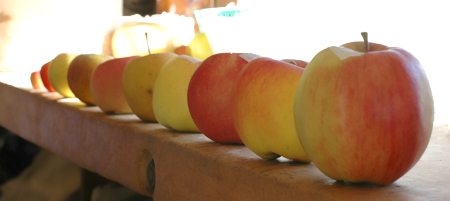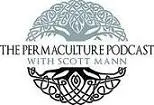Editors note – Since the publication of this essay, there has been a little debate on the NAFEX facebook page as to what the true identity of this apple actually is. I have never claimed to be an expert, and it is totally possible that the ID that I claim is incorrect. I bring this up in the spirit of learning, if someone has a better idea than mine and it is backed up with decent evidence, I am all ears! Regardless of what the true name for this apple is, I feel this is still a strong essay that can stand on its on. Enjoy…
A reoccuring theme here on Autonomy Acres is food, a lot of the time specifically about fruit. Fruit trees, fruit shrubs, growing and foraging fruit, and eating fruit have all been topics covered here over the last four years. Its a favorite subject of mine for good reason, I love fruit! Growing it, eating it, learning about it, cooking with it, you name it, fruit is one of my passions. Especially apples!
Nothing compares to a tree ripened apple on a cool autumn day. They signal the finished accumulation of solar energy, the life of the soil, and the water from rain into a near perfect orb that holds the sweetness of summer within its flesh. They are the inspiration for poetry and legends, and for so many years have played a part in the stories and traditions of cultures from around the cool, temperate climates of the world.
It wasn’t that long ago when every region in the world where apples could and did grow had its own locally adapted varieties. Many of these varieties were used solely for culinary uses or cider and were rarely eaten out of hand and remained nameless, wild apple trees living on the edges of forests and in the hedgerows between fields.
But many of them contained desirable traits and magic that enchanted us – a superb taste, or great storage capabilities, or one that made a particularly smooth cider. Some are just plain gorgeous, or ugly for that matter, but any of these apples that have called to us, have been named, and shared, and sometimes have even become famous.
Presently in 2014 there are roughly 7,500 named varieties of apples grown throughout the world, but it is thought that at one time (probably not all that long ago), there could have been well over 10-12,000 distinct varieties being cultivated worldwide. But with the steady march of progress and the ever increasing trend towards a global monoculture, much of our collective apple heritage has been lost to the bulldozer, the suburbs, and the destruction of our traditional food systems.
While much of our great wealth of apple diversity still exists, it is scattered and gets harder to find with each passing season. The global, industrial cultivation of apples now relies on just 15 varieties for the bulk of its production. How sad it is to have lost so many unique apples (and the land upon which they grew) in favor of a handful of apples that are easy to harvest and ship, and oftentimes resemble wet cardboard in texture and taste.
There is an apple tree a couple miles from my house that I have been visiting now for the last few years. It has been a reliable producer with apples that are hardly troubled by pests or disease. They have tended to be a medium to large apple, but occasionally I will find one that is just huge!
This year I got to the apple tree far later than I ever have and realized that I had been picking this apple a bit too early. This year I didn’t harvest until the middle of October, and because of this later harvest, these apples were really ready to be picked and had fully ripened on the tree.
What I was really interested in was if I could find a graft line anywhere on the trunk. While there is nothing discernible that indicates where the graft union may be (it was probably buried when planted, or slowly covered by the accumulation of mulch and leaves), I am pretty sure that this is a grafted, McIntosh apple tree. Eating it this time of year, versus last year when I harvested them early in September, changed the flavor profile quite a bit, and it became evident that this was an apple that most of us have had at some point in our lives.
It has a noticeable thicker skin, a white to somewhat yellowish flesh that is far from crisp, but is definitely not mealy either, a small short stem, and is easily bruised when dropped. The fruit tends to have a uniformly deep red color to it, that is splashed with small streaks of green. It is not overly juicy or sweet, but has a nice, subtle acidic bite to it that makes it fine apple for eating fresh. It cooked down to an almost perfectly smooth apple butter that only needed a bit of pureeing at the end.
All of those characteristics when compared to other descriptions of McIntosh (see here, and here) seem to be a fairly good match. McIntosh started its journey in Canada back in 1850 and went onto to become a very popular apple for cultivation throughout Western Canada down into New England, and the upper midwest (where I live). It is a large spreading tree, that tends to have reliable harvests, and at least the one I am harvesting from seems to be fairly resistant to some of the more common pests and diseases around here.
Honestly it is not the greatest apple I have ever eaten, but it is still pretty good. Just for the fact that this is a big mature tree that is easy to harvest from, and also produces high quality fruit, and lots of it, makes me glad that this tree is in my neighborhood. The fact that this tree is also in a spot that is very easy to access doesn’t hurt either. This tree is a relic from when this area was still farms and orchards and I can only imagine that this McIntosh tree is in its twilight years.
Before I came to the conclusion that this tree is a McIntosh, last year I collected scion wood from it and grafted it onto one of my !Frankentrees! At the time of grafting, I was calling it Crusader because of a landmark closeby, but it is now looking like I will have to get a new tag made up for that branch.
The fact that this apple tree is a fairly common variety, doesn’t lessen its value as a tree or for what it can provide for one who cares for it. Moreover, the bounty and the knowledge I have gleaned from this tree are invaluable. I love free food, and I also love the chance to learn something new, and this tree has provided both. I admit that it would be fun to find and identify a tree that is more of a rarity than a McIntosh, but the fact that I am pretty certain about my identification means that my observations and research are maturing and starting to pay off!
Sadly it is getting harder to find old trees whether they are a rare variety or not. The continued suburban expansion proceeds with the same vigour as late stage cancer, and it is not only old apple trees that perish and are lost to history, but many other forms of biological diversity are
threatened from this unceasing onslaught.
We may not be able stop the majority of this destruction, but we can be stewards to what is left. We can educate our communities on the importance of fruit and nut trees, we can seek out and help preserve the genetics of threatened species and varieties, and we can also start planting as many trees as we can on whatever land is available to us. Trees are one way of investing in the future, so lets make our great grandkids proud and leave them something positive to remember us by. Peace & Cheers…













